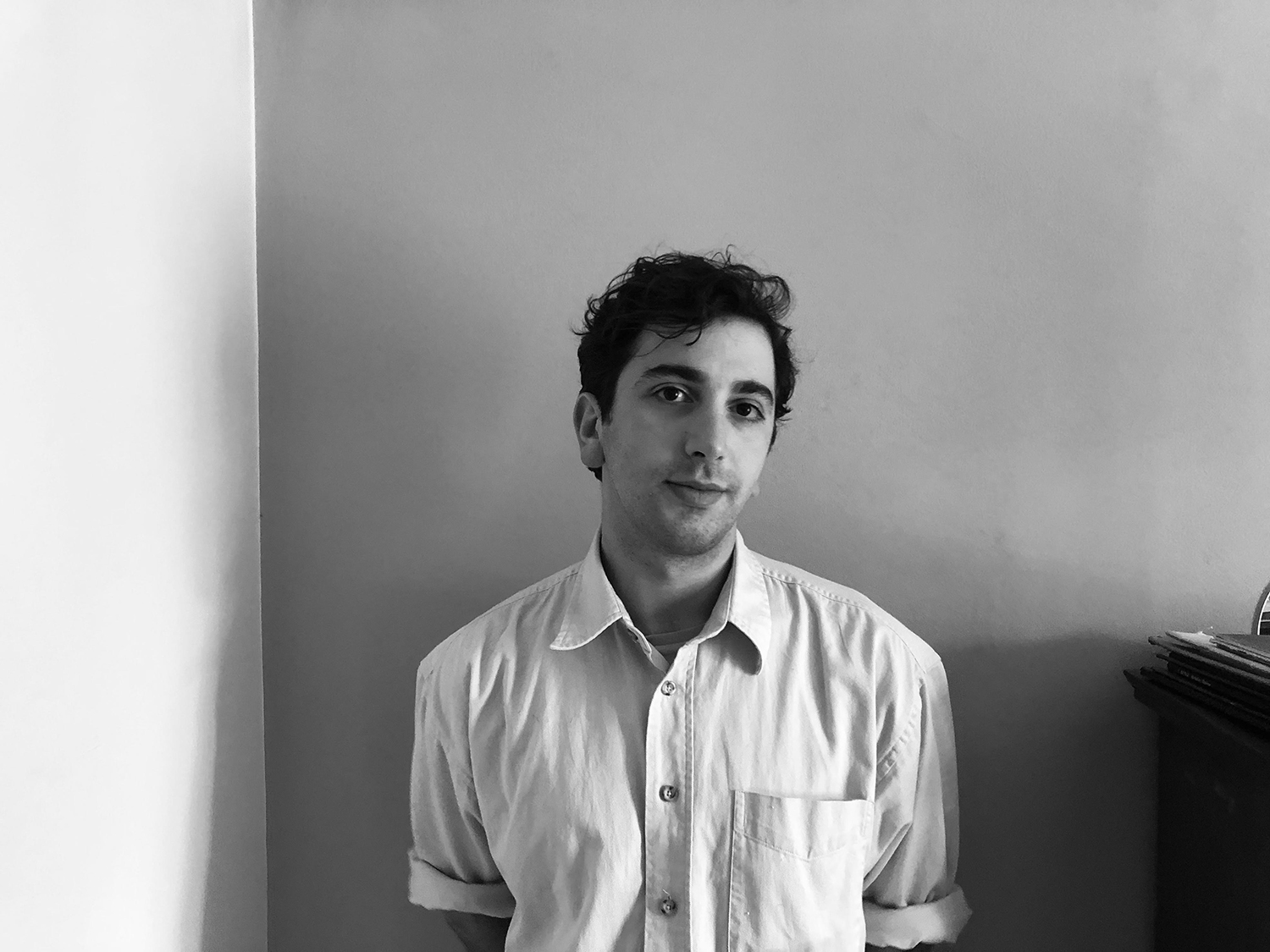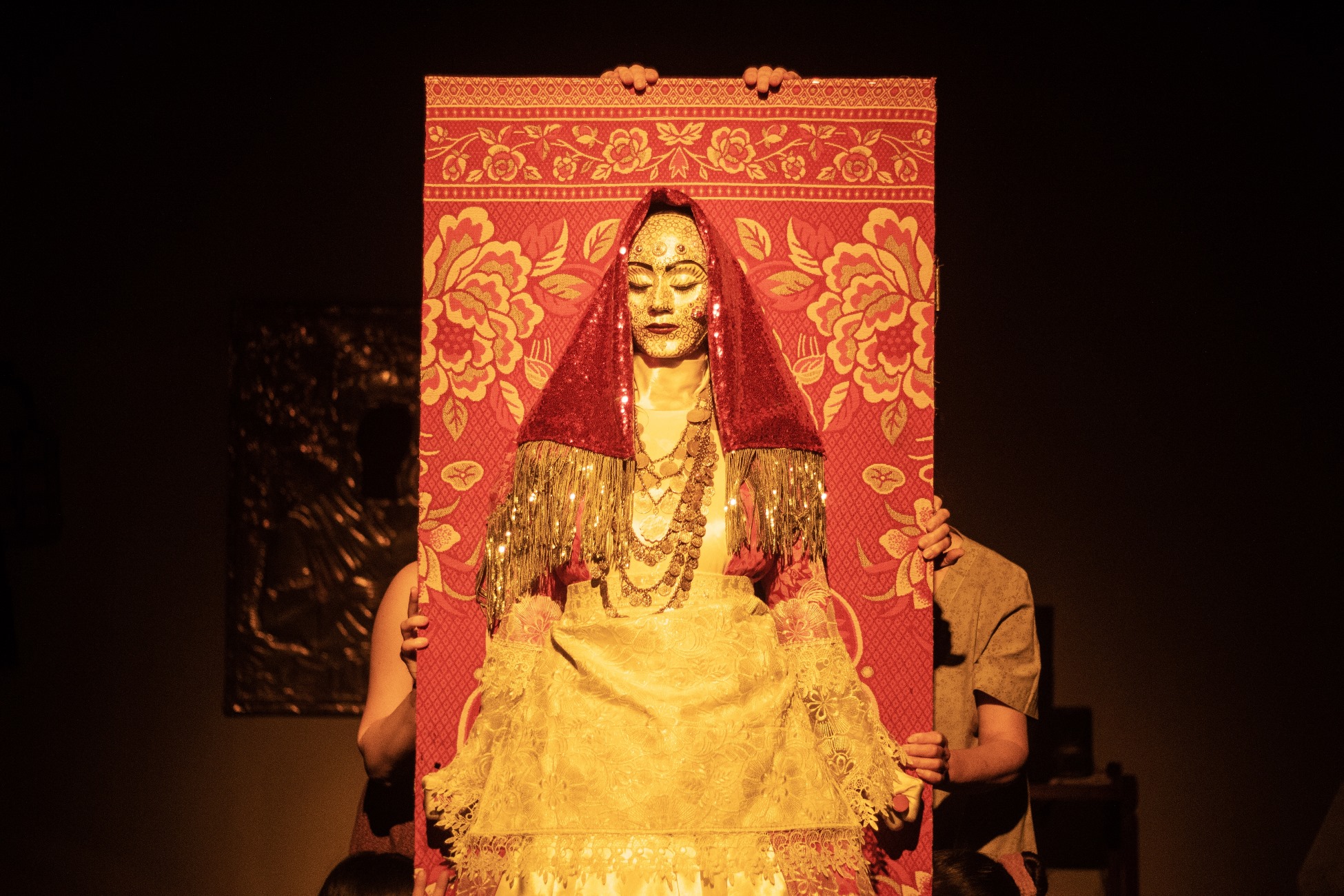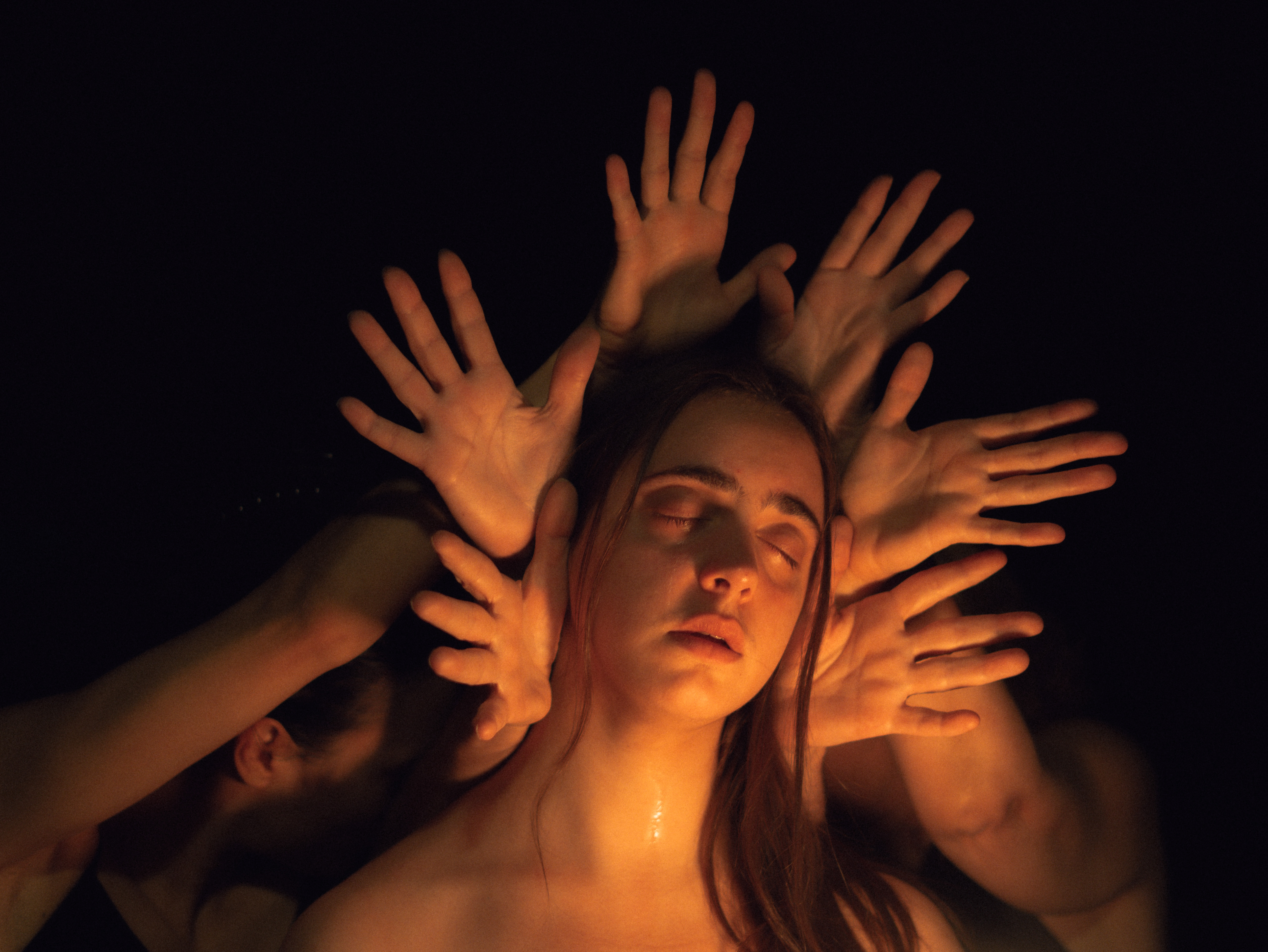A group of people gather on stage around the naked body of a woman. They bathe her, brush her hair and dress her. They wail together as they do this. They scatter handfuls of earth over her. They festoon her with flowers.
The theater piece “Goodbye, Lindita” was inspired by the death of director Mario Banushi’s stepmother. The 25-year-old Greek director, a child of Albanian immigrants, is a rising star in the Greek theater scene. He has channeled his experience of loss into an existential trilogy about life and death, of which “Goodbye Lindita” is the second part. This richly visual and wordless trio of pieces has earned him accolades at home and in the international press. His work is very personal, drawing on his own family history and Albanian heritage, his experience of grief and the rituals surrounding our entrances and exits into this world, as well as on Balkan folk traditions. His work merges religious and folkloric imagery, the domestic and the supernatural. It is tinged with the surreal. Hands emerge from picture frames, bodies convulse and people fly from windows.
After graduating as an actor from the Drama School of the Athens Conservatoire in 2020, Banushi wanted to direct. But because he was so young and without any previous directing experience, he struggled to find a theater in which his work could be performed. Ultimately, he staged his debut piece, “Ragada,” which was inspired by his mother, in an apartment in Athens, where it quickly became a hit with audiences. This led to him being commissioned by the National Theater of Greece to make the second part of the trilogy, “Goodbye, Lindita,” which opened earlier this year and now regularly sells out performances.
Currently on an international tour, “Goodbye, Lindita” recently won the BITEF (Belgrade International Theater Festival) “Jovan Ćirilov” Special Award in Belgrade. According to the judges’ statement, Banushi’s work occupies a place between “life and death, community and solitude, the mundane and sublime.” The concluding part of the trilogy, “Taverna Miresia: Mario, Bella, Anastasia”, inspired by his late father and the taverna he used to own, was showcased in July 2023 at the Athens Epidaurus Festival (an arts festival held annually in Athens and Epidaurus). Michael Billington, revered lead critic at the Guardian for almost 50 years, called him “an exciting new talent.” He has recently been commissioned by the Onassis Foundation to further explore the region’s folk traditions surrounding love and dreams.
K2.0 sat down to talk to Banushi about his family background, the challenges facing young theater-makers in Greece and taking inspiration from his grandmother’s stories.

Photo: Afroditi Kapokaki
K2.0: The pieces that make up this trilogy are clearly very personal, drawing on your own family. What inspired you to create these works and did you intend to create a trilogy from the beginning?
Mario Banushi: When I began working on my first work — “Ragada,” which means stretch marks — I didn’t have in my mind that I would make a trilogy. But after finishing my first work and thinking about the next, I realized that maybe this could be a trilogy, because my first work talked about my mother, and this was something really personal to me. With the second work, “Goodbye, Lindita,” I was thinking about my stepmother. So then I thought, maybe in another piece I could talk about my father. I like the idea that I start with my mother, and then in the middle, there is my stepmother, another important person in my life. And I finish with my father, which means I’m starting and finishing with the two people that brought me to life.
Can you tell me more about your family background and how it has shaped your work?
My parents were living in Albania when they met. They fell in love. And then they left Albania. It was not so easy to be in love there, during those years. It was not so easy to say I want this man. I want this woman. We want each other. So, when the borders opened, they left Albania and walked from Albania to Greece. This took days. And they arrived in Greece, as immigrants.
I am the child of immigrant parents. Some months before I was born, my father returned to Albania because they had a divorce, so I was not with my father for the first months of my life. I was raised by my grandmother, in her family, in her village. I lived there until I was five and a half and then I came back to Greece and lived with my mother and my sisters. I have a lot of images in my mind from this time, the traditional, cultural things, the aesthetics.
I’m interested in some of the specific aesthetic choices you’ve made in “Goodbye, Lindita,” particularly the way you incorporate religious imagery and traditional Balkan rituals of mourning into the work — and this key scene in which the body of the dead woman is tenderly washed and then dressed as a bride.
Color is really important to me. I wanted to put traditional colors — the red and the gold — into the work. I wanted to create a palette which moved from non-colors, dead colors, into red and gold. I wanted the colors to be powerful.
In Albania and Greece, there is a tradition that when a woman dies before she is married, she is put in a wedding dress upon her death. That says a lot about how we see life in these countries. We put a wedding dress on the dead because it’s so important for a woman to put on a wedding dress. I wanted the performance to contain these questions. Do we wash the dead person, or do we baptize her? Do we put a wedding dress on her because she’s dead? Or is it for a wedding? Do the flowers signify grieving? Or something new? I want to create this kind of diptych.

Traditional imagery and colors feature prominently in Banushi’s work. Photo: Theofilos Tismas
I was also really struck by the image of the Black Madonna in the piece. What was the inspiration for this?
I wanted to put something out of our world in this performance. While I was thinking about what I wanted to make, I went on vacation to the island of Kythira, which has an old painting of a Black Madonna, the Madonna Negra. When I entered the empty church, there was no one there except for one Black woman kneeling before it in prayer. It was such a strong image and I wanted to put this image in the show. So, we recreated this painting of the Madonna Negra; it is the same size.
I liked the connection because the main character is from somewhere else, and they baptize her. And it’s my mother’s story. She was baptized in Greece, but she came from Albania. They wanted to change her name and give her a new name, a Greek name. So, I wanted this connection between the Madonna and the main character. I feel like it is saying something about how it is to be from somewhere else.
“Goodbye, Lindita” is a very physical and exposing performance for the actors. How do you work with the ensemble to build trust? What is your creative process like as a director?
I love this process and I’m proud of my team because they really engaged with my ideas and with me. To begin with we shared stories and our feelings about grief. We were really open. For me, as a director, it was important that I also share things. I didn’t want my actors to be open and for me just to listen to them. I also wanted to be open. I tried to create an atmosphere during the rehearsals, with music and lights to make it a comfortable zone for them to be open. Then I started trying some ideas with them that I had drawn before the start of rehearsals. I had in my mind that I wanted to finish with this image I had in my mind, so we were trying a lot of things and in the end it was a big part of the performance.
For me, as a director, it was important that I also share things.
Your work has a very cinematic quality. Are you influenced by film, and if so, which directors inspire you?
I see a lot of films and my work has a lot to do with image, as does cinema. I have a lot of references in my work, but they are not direct references. There are people whose work I am fond of. [Pier Paolo] Pasolini, Roy Andersson, [Andrei] Tarkowsky, for the imagery and the spiritual energy, David Lynch, more for the atmosphere, and Sergej Parajanov, for his use of traditional imagery.
While your work is very visual, the sound design plays a large part in creating the atmosphere in “Goodbye, Lindita.”
Sound is also very important. I had in my mind churches where you hear not just the voice of the priest, but also, during Easter, when we have these fireworks — when Jesus is risen — which is traditional in Greece and other countries. I also wanted to have these rituals and spiritual things mixed with very common things like the sound of the television, voices from outside, birdsong, dogs barking — the sounds of everyday life.
There was a magical quality to “Goodbye, Lindita,” a prevailing sense of the uncanny, with bodies emerging from furniture and hands reaching through the walls. Where did this come from?
I think it comes from my village, and places like it. In the Balkans, we are more open to these kinds of energies, these spiritual things. That’s not to say that I believe in things that are weird. But I do believe things are not so clean, not so easily put into boxes. As a kid, I liked to hear stories about souls and people being buried. I loved these stories from my grandmother.
I also wanted to create suspense. It’s not that I wanted to make a thriller, but I like it when people see a performance and have these moments when they’re shocked or scared, like the moment with the hand, because it reminds me of how I felt as a kid when I was hearing the stories.
But I do believe things are not so clean, not so easily put into boxes.
You originally trained as an actor. What made you transition to being a director?
I started in the drama school of Athens Conservatoire. It’s one of the best drama schools in Athens. We have a lot of drama schools, but this is the only program that lasts for four years. I really loved this experience, though it was very hard. We were there from 10 in the morning until 11 at night, every day. You don’t have any free time. It was at university that I realized I want to become a director. Our teachers were often giving directions, and I always wanted to add something.
Some of my teachers in the beginning said: “you are an actor, you’re a good actor, please focus on this.” But, in the end, they agreed that, yes, you are an actor also, but you can become a director. For our final performances, I did the scenography as well because I like set design. I like all the things. I like to draw, to be involved with design, to sing — and that’s why I want to put everything into my work.
I finished in 2020 and started on my first work. It’s funny, because I will teach at the Athens Conservatoire starting in February, at the same drama school where I studied. They don’t have so many young teachers there, but the students wanted it. They said to the director of the drama school that they want Mario to come and teach us some things.
Earlier this year, theater students and artists in Greece took to the streets to protest changes in the government labor qualification system which they felt devalued their education and their professional status. What was behind these protests? And what was the outcome?
It’s complicated. [The system was changed so that] the diploma you receive as an actor is of the same value as a high school diploma. It’s not the same as if you have been at university. This is weird because drama schools are of a different difficulty. This was voted for by people who don’t understand the arts, which is funny but also sad. That’s why [the students protested] and closed down the theaters, why they occupied buildings and held demonstrations. And some things changed, yes, but very little.
What is the situation like now in Greece for young graduates and emerging artists?
It’s very difficult for young artists. They don’t get residences. It’s hard to make a start. In Greece, many of the people working in theater are famous people or those who have famous families in theater. There are a lot of theater families in Greece. It’s sad because when I started out, it was difficult to find people to believe in me. Of course, I understand that. I am young. They have never seen my work before. But it’s also weird that it’s so difficult to make a start.
The show has been well received and well-reviewed in the international press. The Guardian’s Michael Billington called you an “exciting new talent.” What impact has this had on your career?
It’s important to have this recognition, both internationally and at home. Now “Goodbye, Lindita” is always sold out, which is not something that often happens in Greece. I think it really helped me. I’m still working with the National Theater, but a lot of other doors have opened to me.

Banushi’s trilogy wordlessly conveys deep emotion about family ties, love, and loss. Photo: Nassia Stouraiti
How does the third part of the trilogy, “Taverna Miresia: Mario, Bella, Anastasia,” connect with the previous pieces?
They are connected, but it’s not necessary that you have to see all three to understand this work. If you see “Ragada” and “Goodbye, Lindita,” then you will see connections, but it is not necessary [to see all three]. “Taverna Miresia: Mario, Bella, Anastasia” talks about my father’s absence. As I mentioned, he was not around when I was born, and when I was a child. I was raised by my mother, so I wanted to talk about this. This absence is stronger now, because he’s not alive anymore, but also when I was a child he was not there. The first image I had in my mind was of an empty jacket on a chair that has nobody inside it. The title comes from the restaurant he had in Albania — Miresia means kindness and it has the names of children — Mario and Bella and Anastasia, my sisters.
The absence of text allows you to create a very atmospheric and sensory experience in your work. Is this a way of working you particularly enjoy? Do you think you’ll work with text in future?
It’s funny because a lot of people have asked me if I put no words in it so it would be easier to tour. But my first work didn’t have words and when I made “Goodbye, Lindita,” I didn’t even have it in my mind that it would tour. I was not thinking about that. There are some feelings you can’t convey with a lot of words. Words are important of course, but I also like having eye contact with people, to touch people in this way, to look at the view without talking. For now I like this, but I don’t limit myself. Maybe one day I’ll say I want to do text. I want to do “Romeo and Juliet.” You never know.
This article has been edited for length and clarity. The conversation was conducted in English.
Feature Image: Theofilos Tsimas.
The content of this article is the sole responsibility of K2.0. The views expressed in it are the author’s and do not necessarily reflect the views of K2.0.
Curious about how our journalism is funded? Learn more here.




